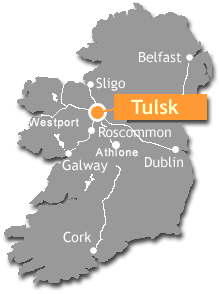Queen Medb (the Old Irish spelling), or if you'd prefer... Middle Irish: Meḋḃ, Meaḋḃ; early modern Irish: Meadhbh; reformed modern Irish Méabh, Medbh; sometimes Anglicised Maeve, Maev or Maive (pronounced May-v). Warrior Queen of Gaelic or 'Celtic' Connacht (Connaught), the western province of Ireland. Her home is Rathcroghan, County Roscommon, the ancient Royal capital of Connacht.
Wait a minute - Roscommon? Isn't Queen Maeve associated with County Sligo?
Perhaps she is, now, but her historical home, the palace of Queen Medb, is ancient Cruachan - which is Rathcroghan, in County Roscommon. Seriously, you can look it up, it's all available through Google.
It was from Cruachan that she began the Táin Bó Cuailnge, the epic Cattle Raid of Cooley, and the Tain Trail runs cross country from Rathcroghan, County Roscommon, right over to Cooley, Co. Louth. And back again.
 |
| Queen Maedhbh of Cruachan, bearing the head of a bull. Bronze statue seen in Beresford Place, Dublin, created by artist Patrick O'Reilly. |
Well, not exactly. Maybe. 'Maeve's Cairn' in Co. Sligo, is the best known burial site of Queen Maeve, but it is one of three possible sites. According to some legends, she is indeed buried in the 40ft (12m) high stone cairn on the summit of Knocknarea (Cnoc na Rí in Irish, Hill of the King/Queen) in County Sligo. The story goes that she is buried upright, facing her enemies in Ulster.
In Bronze or Iron Age burials though, it would be common enough to hack an important dead person apart and bury bits of them along different boundaries, for protection and guardianship. Another story goes that she is buried in the hill of Knockma (Cnoc Medb in Irish, Hill of Maeve), near Belclare in Co. Galway, which is also where Fionnbharr, King of the Connacht Sidhe, holds court. The Fairy connection is an interesting one, and maybe related to her later associations with Mab, the Fairy Queen? The boundary theory holds here too though, as the views from the top of Knockma are spectacular. Very convenient for a guardianship position, we'd say.
Her home in Cruachan, at Rathcroghan, Co. Roscommon is the third (and most likely) burial site, with a long low slab named Misgaun Medb being given as the probable location. In the 'she got chopped up in bitty bits and buried' theory, this is where her soul (most likely to be contained in her head, according to thinking of the time) would be. Or possibly her heart. Whatever was deemed the most important part would have stayed at home, with other bits spreading out at lesser sites along the boundaries.
You can find out more on a dedicated website at: www.QueenMaeve.org
There's also a Facebook Page and you can even follow Queen Meave on Twitter!


